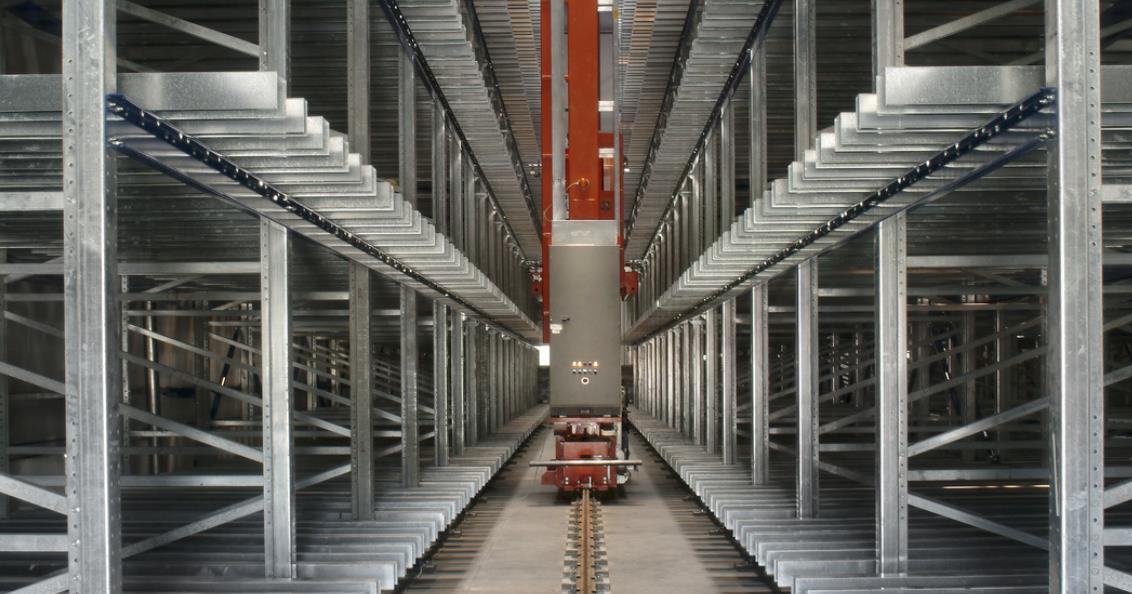The use of stacker crane in automated warehouses
A stacker crane is a type of automated material handling equipment used in warehouses and distribution centers. It is designed to handle the vertical movement of goods, typically pallets or containers, within a storage system. Stacker cranes are utilized in high-density storage systems, such as Automated Storage and Retrieval Systems (AS/RS), to efficiently store and retrieve items from racks or shelves.
The main components of a stacker crane include:
1. Mast or Upright: The mast or upright is the vertical structure of the stacker crane. It provides stability and support for the lifting mechanism.
2. Lifting Mechanism: The lifting mechanism is responsible for raising and lowering the load, typically pallets or containers. It consists of a set of forks or specialized attachments that can be extended or retracted to handle the load.

3. Horizontal Travel Mechanism: Stacker cranes are equipped with a horizontal travel mechanism that allows them to move along a set of rails or tracks. This mechanism enables the stacker crane to access different storage locations within the warehouse.
4. Guidance System: To ensure precise movement and positioning, stacker cranes often incorporate a guidance system. This can include optical sensors, laser guidance technology, or wire guidance systems that help the stacker crane navigate along the designated path.
5. Control System: Stacker cranes are typically controlled by a sophisticated control system, which can be integrated with the warehouse management software or Warehouse Control System (WCS). The control system receives commands from the warehouse management software and coordinates the stacker crane's movements for efficient storage and retrieval operations.
6. Safety Features: Stacker cranes are equipped with safety features to ensure the protection of goods, equipment, and personnel. These features may include collision avoidance systems, sensors for detecting obstacles, emergency stop mechanisms, and safety protocols to prevent accidents during operation.
Stacker cranes are a key component of automated warehouses, especially in high-density storage systems such as Automated Storage and Retrieval Systems (AS/RS). These cranes are designed to handle the vertical movement of goods within the warehouse, allowing for efficient storage and retrieval of pallets or containers. Here's some information about the use of stacker cranes in automated warehouses:
1. Vertical Storage and Retrieval: Stacker cranes are primarily used for vertical storage and retrieval of goods. They operate on a system of rails or tracks and are guided along the warehouse aisles. The cranes are equipped with a lifting mechanism that can raise and lower the load, allowing for precise positioning and storage in the rack structure.
2. High-Density Storage: Stacker cranes enable high-density storage by utilizing the vertical space of the warehouse. They can access multiple rack levels and handle pallets or containers in a controlled manner, stacking them one on top of the other. This maximizes the storage capacity of the warehouse and optimizes space utilization.
3. Automated Operation: Stacker cranes are typically fully automated and integrated into the warehouse control system. They receive commands from the warehouse management software or Warehouse Control System (WCS) to perform specific tasks such as storing or retrieving pallets. The automation ensures accurate and efficient operations, minimizing human intervention.
4. Handling Capacity and Speed: Stacker cranes are designed to handle heavy loads and can have high lifting capacities, depending on the specific model. They can efficiently handle pallets or containers weighing several tons. The speed of the stacker crane's movements, including lifting, lowering, and horizontal travel, is optimized for quick and precise operations.
5. Safety Features: Stacker cranes are equipped with safety features to ensure the protection of goods, equipment, and personnel. These features may include collision avoidance systems, sensors for detecting obstacles, and emergency stop mechanisms. Safety protocols and regulations are followed to prevent accidents and ensure safe operation within the warehouse environment.
6. Integration with Warehouse Management Systems: Stacker cranes are seamlessly integrated into Warehouse Management Systems (WMS) or Warehouse Control Systems (WCS). This integration allows for real-time communication between the stacker cranes and the warehouse management software, enabling efficient task assignment, inventory tracking, and optimization of the material handling process.
7. Increased Efficiency and Productivity: The use of stacker cranes in automated warehouses significantly improves efficiency and productivity. They can quickly retrieve specific pallets from the storage system, reducing retrieval times and improving order fulfillment speed. Stacker cranes also minimize human error and increase accuracy in storage and retrieval operations.
8. Scalability and Flexibility: Automated warehouses with stacker cranes are designed to be scalable and flexible. Additional stacker cranes can be added or reconfigured to accommodate changing storage requirements or increased order volumes. This scalability allows the warehouse to adapt to business growth and changing operational needs.
9. Maintenance and Support: Stacker cranes require regular maintenance and inspection to ensure their optimal performance. Manufacturers or service providers often offer maintenance programs and support services to keep the equipment running smoothly and minimize downtime.
10. Cost Considerations: Implementing stacker cranes in an automated warehouse involves significant upfront investment. However, over time, the increased efficiency, space utilization, and productivity gains can lead to cost savings in labor, storage space, and operational expenses.
Stacker cranes play a crucial role in the automation and optimization of warehouse operations. With their ability to handle vertical storage and retrieval, these cranes contribute to increased efficiency, improved inventory management, and enhanced overall productivity in automated warehouses.
